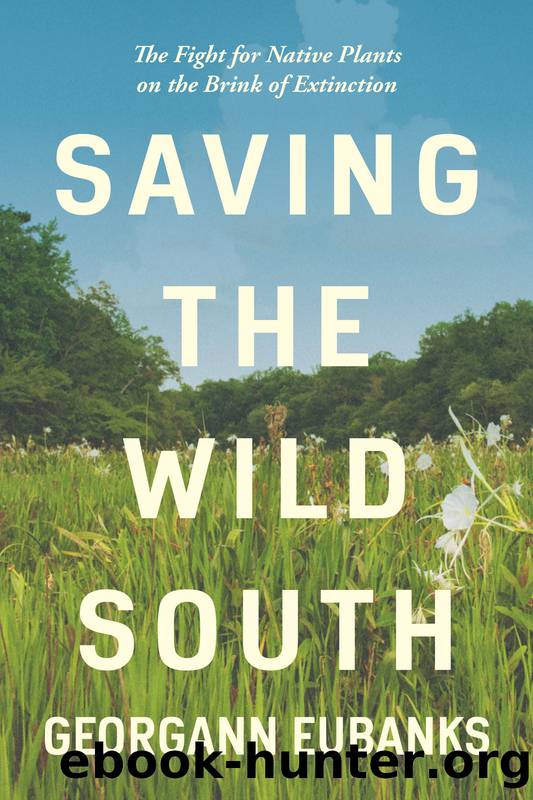Saving the Wild South by Georgann Eubanks;

Author:Georgann Eubanks;
Language: eng
Format: epub
Publisher: University of North Carolina Press
Published: 2021-01-15T00:00:00+00:00
Tracy Cook, curator of horticulture at the Huntsville Botanical Garden, picks up a strand of Morefieldâs leather flower vine (Clematis morefieldii) growing after the plantâs blooming season along the gardenâs Matthews Nature Trail. Photo by Georgann Eubanks.
Tracy and I made our way over to a second group of the Morefieldâs leather flowers, in a sunnier location beside a running creek. These plants were clearly happier than the ones in shade. I hated that Iâd missed the blooming time.
We got back on the cart to ride to the nonpublic section of the garden. Tracy took me into a greenhouse where seedlings of the leather flower were growing. Huntsville Botanical Garden is partnering with ABG on native plant cultivation and conservation, and Morefieldâs leather flower is a focal point here.
I asked Tracy about the lack of support and appreciation these days for horticulture as a field of study, noting how a number of once-dynamic horticulture programs at colleges and universities in the South and elsewhere had been folded into other academic departments or eliminated owing to underenrollment, decreasing state resources, and faculty retirements.
She shook her head. âHorticulture is still seen as stoop labor,â she said. âItâs not always perceived as science, but it is science. Itâs applied science. Itâs boots on the ground. Researchers who spend their days in a lab with tissue fragments of a plant often have to depend on us to know enough to recognize when something is going wrong with the whole plant.â
For her part, Tracy has continued following the literature about the ongoing threats to Clematis morefieldii in the wild. Besides being hurt by industrial and residential development, she told me, the plant is plagued by destructive deer, mealybugs, and mice.
âRodents find the seeds very tasty,â Tracy said, âand the plant will abort flowers if the shade gets too deep where they are growing.â She noted that there are actually four known kinds of leather flowers in Alabama, but they donât tend to cross-pollinate, because their bloom periods donât overlap. What delineates one from another, she said, is how pollinators interact with them: four different types of bees are involved. âBut Iâm not a bug gal,â Tracy said, grinning. âPollinators definitely affect leather-flower livelihood, and pollinators get thrown off by climate change, including the extremes of drought and rain that weâve experienced lately,â she said.
So many challenges from so many factors. We were still talking about preserving biodiversity in the South when Tracy got me back to my car in the parking lot. âWe have to conserve habitats, not just the species,â she said finally. âWe donât know where the next cure for cancer is coming from. The worldâs wealth is really in our plants.â
I thanked her for her time, and she promised to send me her masterâs thesis and some pictures of the Morefieldâs leather flower from when they were blooming in the garden.
My next stop was a little more than an hour northeast of Huntsville. Iâd arranged for a visit to the Sewanee Herbarium, at the University of the South in southeastern Tennessee.
Download
This site does not store any files on its server. We only index and link to content provided by other sites. Please contact the content providers to delete copyright contents if any and email us, we'll remove relevant links or contents immediately.
| Anatomy | Animals |
| Bacteriology | Biochemistry |
| Bioelectricity | Bioinformatics |
| Biology | Biophysics |
| Biotechnology | Botany |
| Ecology | Genetics |
| Paleontology | Plants |
| Taxonomic Classification | Zoology |
Sapiens: A Brief History of Humankind by Yuval Noah Harari(13984)
The Tidewater Tales by John Barth(12391)
Mastermind: How to Think Like Sherlock Holmes by Maria Konnikova(6936)
Do No Harm Stories of Life, Death and Brain Surgery by Henry Marsh(6683)
The Thirst by Nesbo Jo(6432)
Why We Sleep: Unlocking the Power of Sleep and Dreams by Matthew Walker(6350)
Life 3.0: Being Human in the Age of Artificial Intelligence by Tegmark Max(5182)
Sapiens by Yuval Noah Harari(5118)
The Longevity Diet by Valter Longo(4856)
The Body: A Guide for Occupants by Bill Bryson(4578)
The Rules Do Not Apply by Ariel Levy(4520)
The Immortal Life of Henrietta Lacks by Rebecca Skloot(4248)
Why We Sleep by Matthew Walker(4190)
Animal Frequency by Melissa Alvarez(4148)
Yoga Anatomy by Kaminoff Leslie(4100)
The Hacking of the American Mind by Robert H. Lustig(4080)
All Creatures Great and Small by James Herriot(3980)
Barron's AP Biology by Goldberg M.S. Deborah T(3942)
Double Down (Diary of a Wimpy Kid Book 11) by Jeff Kinney(3922)
